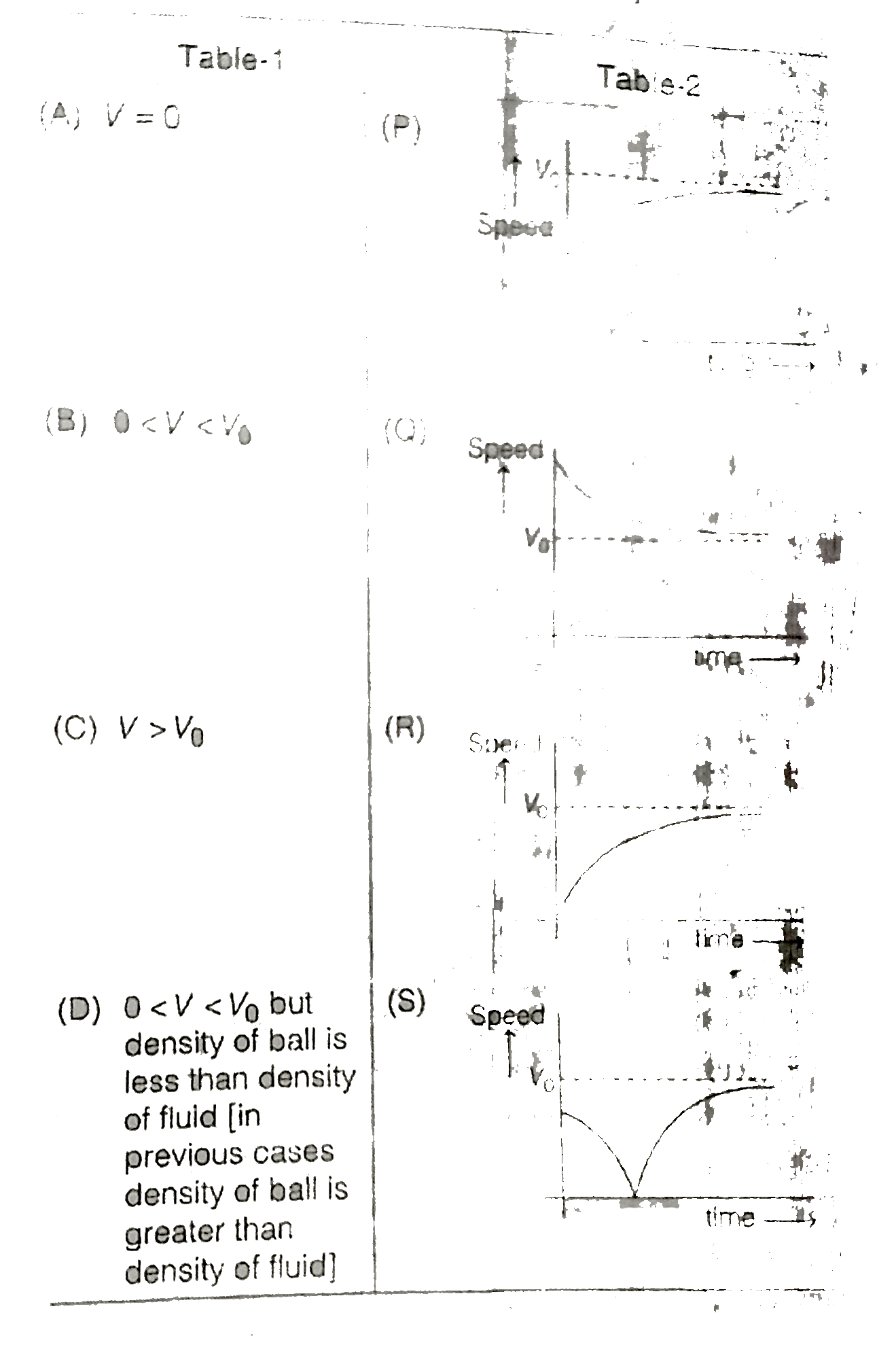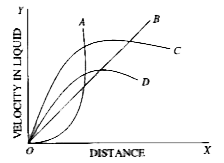Uniform speed of 2 cm diameter ball is 20cm/s in a viscous liquid. Then, the speed of 1 cm diameter ball in the same liquid is
5cms−1
10cms−1
40cms−1
80cms−1
The correct Answer is:A
To solve the problem, we need to find the speed of a 1 cm diameter ball in a viscous liquid, given that a 2 cm diameter ball moves at a uniform speed of 20 cm/s. This speed is the terminal velocity, which is influenced by the size of the ball.
1. Understand the relationship between terminal velocity and radius:
The terminal velocity (V) of a sphere in a viscous fluid is directly proportional to the square of its radius (R). This can be expressed as:
V∝R2
This means that if we have two balls with different diameters, we can set up a ratio of their terminal velocities based on the square of their radii.
2. Define the variables:
- Let V1 be the terminal velocity of the first ball (2 cm diameter).
- Let V2 be the terminal velocity of the second ball (1 cm diameter).
- The radius of the first ball R1=2 cm2=1 cm.
- The radius of the second ball R2=1 cm2=0.5 cm.
- Given V1=20 cm/s.
3. Set up the ratio of terminal velocities:
Using the relationship V∝R2, we can write:
V1V2=R21R22
4. Substituting the values:
Substitute R1=1 cm and R2=0.5 cm:
20V2=(1)2(0.5)2=10.25=4
5. Solve for V2:
Rearranging the equation gives:
20=4×V2
Therefore,
V2=204=5 cm/s
6. Conclusion:
The speed of the 1 cm diameter ball in the same viscous liquid is 5 cm/s.
Final Answer:
The speed of the 1 cm diameter ball in the same liquid is 5 cm/s.
---
The terminal velocity (V) of a sphere in a viscous fluid is directly proportional to the square of its radius (R). This can be expressed as:
V∝R2
This means that if we have two balls with different diameters, we can set up a ratio of their terminal velocities based on the square of their radii.
- Let V1 be the terminal velocity of the first ball (2 cm diameter).
- Let V2 be the terminal velocity of the second ball (1 cm diameter).
- The radius of the first ball R1=2 cm2=1 cm.
- The radius of the second ball R2=1 cm2=0.5 cm.
- Given V1=20 cm/s.
Using the relationship V∝R2, we can write:
V1V2=R21R22
Substitute R1=1 cm and R2=0.5 cm:
20V2=(1)2(0.5)2=10.25=4
Rearranging the equation gives:
20=4×V2
Therefore,
V2=204=5 cm/s
The speed of the 1 cm diameter ball in the same viscous liquid is 5 cm/s.
The speed of the 1 cm diameter ball in the same liquid is 5 cm/s.
Topper's Solved these Questions
- BOOK - DC PANDEY ENGLISHCHAPTER - FLUID MECHANICSEXERCISE - Level 1 Subjective36videos
FLUID MECHANICS
- BOOK - DC PANDEY ENGLISHCHAPTER - FLUID MECHANICSEXERCISE - Subjective Question2videos
FLUID MECHANICS
- BOOK - DC PANDEY ENGLISHCHAPTER - FLUID MECHANICSEXERCISE - Assertion and Reason1videos
FLUID MECHANICS
- BOOK - DC PANDEY ENGLISHCHAPTER - EXPERIMENTSEXERCISE - Subjective15videos
EXPERIMENTS
- BOOK - DC PANDEY ENGLISHCHAPTER - GENERAL PHYSICSEXERCISE - INTEGER_TYPE2videos
GENERAL PHYSICS
Similar Questions
The speed of a ball of radius 2 cm in a viscous liquid is 20 cm/s. Then the speed of ball of radius I cm in the same liquid is
View SolutionA steel ball of mass m falls in a viscous liquid with terminal velocity v, then the steel ball of mass 8m will fall in the same liquid with terminal velocity
View SolutionA small lead ball is falling freely in a viscous liquid The velocity of the ball
View SolutionA ball is thrown downward In a viscous fluid with speed V. Terminal speed of ball is V0
 View Solution
View SolutionA liquid of specific gravity 1.5 is observed to rise 3.0cm in a capillary tube of diameter 0.50mm and the liquid wets the surface of the tube. Calculate the excess pressure inside a spherical bubble of 1.0cm diameter blown from the same liquid.
View SolutionA solid metal sphere of 6 cm diameter is melted and a circular sheet of thickness 1 cm is prepared. Determine the diameter of the sheet.
View SolutionA spherical ball is dropped in a long column of a viscous liquid. The speed of the ball as a function of time may be best represented by the graph
 View Solution
View SolutionA golf ball has diameter equal to 4.2cm. Find its capacity.
View SolutionA small spherical solid ball is dropped in a viscous liquid. It journey in the liquid is best described in the Fig. 15.5.1 by
 View Solution
View SolutionA cone of height 15 cm and diameter 7 cm is mounted on a hemisphere of same diameter. Determine the volume of the solid thus formed.
View Solution

